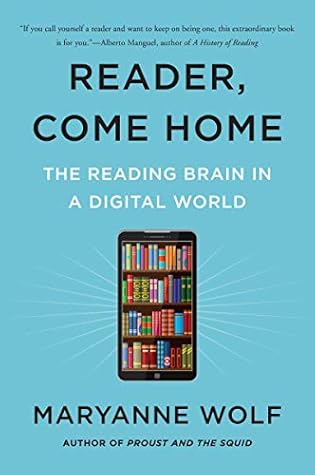More on this book
Community
Kindle Notes & Highlights
Read between
November 11 - November 18, 2024
The act of taking on the perspective and feelings of others is one of the most profound, insufficiently heralded contributions of the deep-reading processes.
There are many things that would be lost if we slowly lose the cognitive patience to immerse ourselves in the worlds created by books and the lives and feelings of the “friends” who inhabit them. And although it is a wonderful thing that movies and film can do some of this, too, there is a difference in the quality of immersion that is made possible by entering the articulated thoughts of others. What will happen to young readers who never meet and begin to understand the thoughts and feelings of someone totally different? What will happen to older readers who begin to lose touch with that
...more
Oatley and his York University colleague Raymond Mar suggest that the process of taking on another’s consciousness in reading fiction and the nature of fiction’s content—where the great emotions and conflicts of life are regularly played out—not only contribute to our empathy, but represent what the social scientist Frank Hakemulder called our “moral laboratory.”35 In this sense, when we read fiction, the brain actively simulates the consciousness of another person, including those whom we would never otherwise even imagine knowing. It allows us to try on, for a few moments, what it truly
...more
We need to ensure that human beings do not fall into the trap that Edward Tenner described when he said, “It would be a shame if brilliant technology43 were to end up threatening the kind of intellect that produced it.”
In his book The Shallows, Nicholas Carr reminds us of a concern34 raised by Stanley Kubrick that in a digital culture we should not be worrying so much about whether the computer will become like us, but whether we will become like it. Reading research buttresses the validity of such concerns. Our reading-brain circuit is the sum of many processes, most of which are continuously being shaped by the environmental demands placed on them—or not. For
The psychologist Howard Gardner used the MIT scholar Seymour Papert’s famous description of the child’s “grasshopper mind”6 to describe the spasmodic way our digital young now typically “hop from point to point, distracted from the original task.”7 Like Frank Schirrmacher, the neuroscientist Daniel Levitin places such attention-flitting, task-switching behavior within the context of our evolutionary reflex, the novelty bias that pulls our attention immediately toward anything new: “Humans will work just as hard to obtain8 a novel experience as we will to get a meal or a mate. . . . In
...more
Some others, such as the psychiatrist Edward Hallowell, go so far as to suggest that we are creating a cadre of children with environmentally induced attentional deficits because of the incessant, obsession-promoting hold that digital distractions pose for a child. This clinician’s concern is that the increasing number of children diagnosed with attention-based learning deficits may reflect not only better, earlier diagnoses, but also the creation of new forms of attention deficit in a generation of distracted children.
No self-respecting internal review board at any university would allow a researcher to do what our culture has already done with no adjudication or previous evidence: introduce a complete, quasi-addictive set of attention-compelling devices without knowing the possible side effects and ramifications for the subjects (our kids).
When you speak to your children, you expose them to words that are all around them. A wonderful thing. When you read to your children, you expose them to words they never hear in other places and to sentences no one around them uses. This is not simply the vocabulary of books, it is the grammar of stories and books and the rhythm and alliteration of rhymes and limericks and lyrics that are not to be found anywhere else quite so delightfully. All of these earliest experiences provide the ideal beginnings of the reading life: first and foremost, human interaction and its associations with touch
...more
The rhythm in music and the rhymes of language provide contributions beyond phonemes. Think what happens when you read to a three- or four-year-old child: you automatically begin to speak more clearly and more intentionally. In the process, the prosodic or melodic contour of your voice helps to convey the meanings of words to the child. You change the register of your everyday voice and become someone else. Without ever a thought, you who read to young children are effortlessly accelerating the development of many of the most important parts of the reading circuitry: the smallest sounds of
...more


